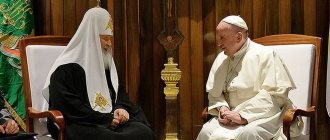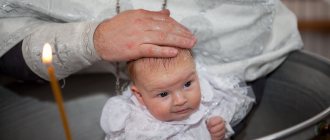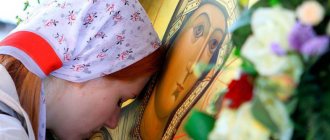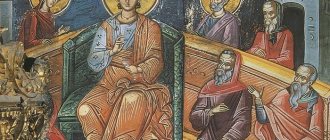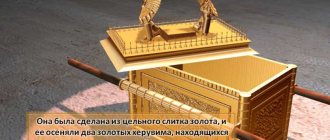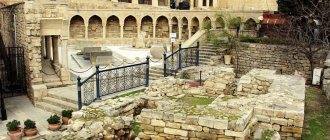The tradition of making the sign of the cross goes back so far into ancient times that it is impossible to trace when it originated. Research by P.P. Soykin, author of the Orthodox Theological Encyclopedia, allow us to say that the ritual first appeared in apostolic times.
According to the records of one of the first theologians, Tertullian, who lived in 160-220, the symbol of the cross was used by his contemporaries everywhere: before and after leaving home, before meals, business negotiations, when saying goodbye or meeting.
Church books mention John the Baptist (John the Baptist) as one of the first to use the sign of the cross. In fact, one can only guess where the tradition came from, but the fact is undeniable - the sign of the cross is an integral part of Christianity and one of its most important rituals. But why do Orthodox Christians cross themselves from right to left, and Catholics vice versa? Let's look into this issue.
The most significant similarities between Orthodoxy and Catholicism
| Orthodoxy | Catholicism |
| The foundation of all life is the Lord Jesus Christ. | |
| Believers strive to live according to the commandments of Christ. | |
| They profess faith in the Holy Trinity, God, one in Three Persons - Father, Son and Holy Spirit. | |
| They have apostolic succession. | |
| They have seven church sacraments. | |
| Recognize the authority of Holy Scripture and Holy Tradition. | |
| They share a common spiritual Tradition of the first millennium of Christianity. | |
| They venerate Mary, the Mother of our Lord Jesus Christ, as the Ever-Virgin and Mother of God. | |
| They have a number of common saints who lived before the Great Schism of 1054. | |
| They have a general idea of the family. | |
| They call on everyone to respect the inalienable right to life, and do not accept abortion, euthanasia and other methods of killing a person. | |
| Homosexual marriages are not recognized. | |
| They preach the Gospel of Christ in the modern world. |
"Filioque"
The key dogmatic divergence between the Orthodox and Catholic churches is the “filioque” (Latin filioque - “and the Son”) - an addition to the Latin translation of the Creed, adopted by the Western (Roman) Church in the 11th century in the dogma of the Trinity: the procession of the Holy Spirit not only from God the Father, but “from the Father and the Son.”
Pope Benedict VIII included the term “filioque” in the Creed in 1014, which caused a storm of indignation on the part of Orthodox theologians.
It was the “filioque” that became the “stumbling block” and caused the final division of the churches in 1054.
In modern Catholic theology, the attitude towards the filioque, oddly enough, has changed greatly. Thus, on August 6, 2000, the Catholic Church published the declaration “Dominus Iesus” (“Lord Jesus”). The author of this declaration was Cardinal Joseph Ratzinger (Pope Benedict XVI).
In this document, in the second paragraph of the first part, the text of the Creed is given in the wording without the “filioque”: “Et in Spiritum Sanctum, Dominum et vivificantem, qui ex Patre procedit, qui cum Patre et Filio simul adoratur et conglorificatur, qui locutus est per prophetas” . (“And in the Holy Spirit, the Lord who gives life, who proceeds from the Father, to whom, together with the Father and the Son, belongs worship and glory, who spoke through the prophets”).
No official, conciliar decisions followed this declaration, so the situation with the “filioque” remains the same.
The main difference between the Orthodox Church and the Catholic Church is that the head of the Orthodox Church is Jesus Christ; in Catholicism, the church is headed by the Vicar of Jesus Christ, its visible head (Vicarius Christi), the Pope.
Doctrine of the Supremacy of the Pope
The doctrine of the extraordinary and sole power of the Pope (primacy) over the entire Christian Church has become a source of isolation for Catholicism since the first centuries of Christian history.
In 494, the Pope first began to be called the “vicar of Christ” on earth. In the VI-VII centuries. The heads of the Western Church tried to contrast their decisions with the decrees of the Ecumenical Councils, for which, in particular, Pope Gregory I was condemned for heresy by the VI Council (681). In 1054, the claims of the Roman throne to supreme power over the Patriarch of Constantinople became one of the reasons for the schism between the Western and Eastern churches. Subsequently, recognition of the supremacy of the power of the Roman high priest was put forward by the Western Church as a prerequisite during attempts to unite churches at the Second Council of Lyon (1274) and Ferrara-Florence (1438-1445) Councils. As a dogma of Catholicism, the doctrine of the primacy of the Pope was approved at the First Vatican Council (1870). In Orthodoxy, the highest ecclesiastical authority, competent to resolve issues concerning the fundamentals of religious doctrine, belongs exclusively to the Ecumenical Councils.
They have purgatory, and we have ordeals.
Orthodoxy and Catholicism also differ in their understanding of what the human soul goes through after death. Catholicism has a dogma about purgatory - a special state in which the soul of the deceased is located. Orthodoxy denies the existence of purgatory, although it recognizes the need for prayers for the dead.
In Orthodoxy, unlike Catholicism, there is a teaching about aerial ordeals, obstacles through which the soul of every Christian must pass on the way to the throne of God for private judgment.
Two angels lead the soul along this path. Each of the ordeals, of which there are 20, is controlled by demons - unclean spirits who are trying to take the soul going through the ordeal to hell. In the words of St. Theophan the Recluse: “No matter how wild the thought of ordeals may seem to wise men, they cannot be avoided.” The Catholic Church does not recognize the doctrine of ordeals.
Basic tenets and postulates
To understand who Catholics are, you need to pay attention to the basic tenets of their faith. The main dogma of Catholicism, which distinguishes it from other areas of Christianity, is the thesis that the Pope is infallible. However, there are many known cases when Popes, in the struggle for power and influence, entered into dishonest alliances with large feudal lords and kings, were obsessed with the thirst for profit and constantly increased their wealth, and also interfered in politics.
The next postulate of Catholicism is the dogma of purgatory, approved in 1439 at the Council of Florence. This teaching is based on the fact that humans are sent to purgatory, which is an intermediate level between hell and heaven. There she can be cleansed of her sins through various tests. Relatives and friends of the deceased can help his soul cope with trials through prayers and donations. It follows from this that a person’s fate in the afterlife depends not only on the righteousness of his life, but also on the financial well-being of his loved ones.
An important postulate of Catholicism is the thesis about the exclusive status of the clergy. According to him, without resorting to the services of the clergy, a person cannot independently earn God's mercy. A Catholic priest has serious advantages and privileges compared to the ordinary flock. According to the Catholic religion, only the clergy has the right to read the Bible - this is their exclusive right. This is prohibited for other believers. Only publications written in Latin are considered canonical.
Catholic dogmatics determines the need for systematic confession of believers before the clergy. Everyone is obliged to have his own confessor and constantly report to him about his own thoughts and actions. Without systematic confession, the salvation of the soul is impossible. This condition allows the Catholic clergy to penetrate deeply into the personal lives of their flock and control a person's every move. Constant confession allows the church to have a serious influence on society, and especially on women.
How are Greek Catholics and Jews baptized?
Speaking about Catholics, it is necessary to note the fact that there are Roman Catholics and Greek Catholics. Both of them have something in common and something different.
- Greek Catholics recognize the Pope as the visible head of the Church and consider themselves to be part of the Roman Catholic Church.
- It is worth saying that Greek Catholics have many things in common with Orthodox Christians, including the method of drawing the cross.
- They cross themselves with their right hand, and with their hand they draw the cross in this way: from top to bottom, from right to left.
- Also, Greek Catholics and Orthodox Christians have a common finger shape. When baptizing, the fingers are folded in this way: the first 3 fingers are joined together, and the little finger and ring finger are pressed to the palm.
- Representatives of this movement living in Western Ukraine often perform other movements during baptism. For example, a hand movement is made that marks the pierced side of Christ.
- If we take Roman Catholics for comparison, they apply the sign of the cross differently. The movements proceed from the head to the belly, and then from the left shoulder to the right. In this case, the fingers fold differently. This is both a two-finger and a three-finger addition.
About the baptism of Greek Catholics and Jews
Now let's talk about Jews:
Let's start with the fact that the traditional religion professed by this people is Judaism. The words “Jew” and “Jew” are very similar and today have the same meaning in many languages of the world. However, in our country it is generally accepted that “Jew” is still a nationality, and “Jew” is a professed religion. Before answering the question “How are Jews baptized?” Let’s talk a little about what the “cross” symbol itself means to them. By the way, it would be more appropriate to ask the question “Are Jews baptized at all?” So, in ancient times, the cross was associated among the Jews with fear, punishment and death itself. While for Christians, the cross is the main symbol that can protect and protect from misfortune and troubles. Today, Jews recognize the holy cross, but they attach a slightly different meaning to it. For them, this is a symbol of the rebirth of the Savior
By and large, the cross does not carry such importance (as it does for Christians), therefore, accordingly, there is no need to impose a sign on oneself. This suggests the conclusion that Jews are not baptized at all.
Eastern Rite Catholics
Their crossing process has some peculiarities. So the middle, thumb and index fingers are folded together, the ring and little fingers are pressed against the palm. Accordingly, two folded fingers symbolize the dual nature of Jesus, and the other three symbolize the Holy Trinity.
Another method is to cross the open palm with the fingers open and pressed together, while the thumb is slightly bent inward of the palm. The meaning of the gesture is openness to Christ. Knowing how Catholics cross themselves, it is not difficult to notice that all methods of crossing are performed with the right hand, and it is brought first to the left shoulder, then to the right.
The most widespread and professed are perhaps Christianity, Judaism and Islam. Despite the fact that in the age of information technology, every person has access to almost any information, many people do not know what the essence of each religion is, what they have in common and how they actually differ from each other. Today we propose to talk about the differences in applying the sign of the cross in different religions.
How to be baptized in the Church correctly?
Orthodox Christians must be baptized according to certain rules:
- Rule 1 – Three fingers must be used.
- Rule 2 – As a sign of equality and symbolism of the Trinity, the fingers are folded at the same level.
- Rule 3 – The ring and little fingers touch the middle of the palm.
- Rule 4 – When touching the forehead, you need to say: “In the name of the Father,” to the stomach: “... and the Son...”, to the shoulders: “... and the Holy Spirit.”
This sequence should be observed not only in Church, but also at home - before meals, before bed, immediately after waking up. It is impossible to carry out the rebaptism procedure anyhow; you must strictly follow the described rules. When entering the Church, you need to be baptized three times and each time accompanied by a bow, this is how a person “says” that he believes in Jesus Christ and His sacrifice for the sins of the world. Crossing should not be quick, because it needs to be done meaningfully, understanding what words are being pronounced.
You also need to be baptized in front of the icon in a certain way:
- It is necessary to choose a Saint to whom you are supposed to pray.
- Approach him and immediately cross himself.
- Light a candle if necessary.
- Pray to him and ask for what was the intention before.
- Cross yourself again
The laying on of a cross strengthens prayer if it is done for God and not for people. This is an important procedure, non-compliance with which indicates that a person does not respect church rituals and does not fear God.
We advise you to study Prayer of Thanks to St. Nicholas the Wonderworker
You can be baptized while sitting, but only if it is really difficult to stand - you have health problems, you feel some kind of weakness. In the Church you may not be baptized at all if there is no urge within you to do so. Any religious ritual must be performed by a person voluntarily and from the heart. Otherwise, it does not have miraculous power and any special meaning, both for man and for God.
Man's destiny
The Catholic Church teaches that people are burdened by original sin (with the exception of the Virgin Mary), that is, every person from birth has a grain of Satan. Therefore, people need the grace of salvation, which can be obtained by living by faith and doing good works. The knowledge of the existence of God is, despite human sinfulness, accessible to the human mind. This means that people are responsible for their actions. Every person is loved by God, but at the end the Last Judgment awaits him. Particularly righteous and godly people are ranked among the Saints (canonized). The church keeps a list of them. The process of canonization is preceded by beatification (beatification). Orthodoxy also has a cult of Saints, but most Protestant movements reject it.
Spreading
Catholicism is widespread in Western European (France, Spain, Belgium, Portugal, Italy) and Eastern European (Poland, Hungary, partly Latvia and Lithuania) countries, as well as in the countries of South America, where the overwhelming majority of the population professes it. There are also Catholics in Asia and Africa, but the influence of the Catholic religion is insignificant here. Catholics in Russia are a minority compared to Orthodox Christians. There are about 700 thousand of them. Catholics in Ukraine are more numerous. There are about 5 million people.
If Thomas is shocked by his shamelessness, it is not that the other disciples were confident in their faith, which the famous painting by Caravaggio shows very well, where almost in the background the faces of the other two disciples express curiosity, surprise and the Surprise that follows great doubt. But Thomas' distrust is even defined here as happy, because it leads to knowledge and profession of faith. In the following verse, even Jesus gives Thomas an interpretative clue to his unbelief.
Stretch out your hand, place it on your side and observe: For their iniquity they recognized my passion and my resurrection in order to exclaim with you: Lord my God, glory to you! This is why the Church wants to propose the figure of Thomas today. On the one hand, all the considerations arising from the apostle's journey from doubt to faith, on the other hand, the decisive element is the certainty that the passion and resurrection concern precisely that Jesus of Nazareth, who turns out to be Christ and Lord, Messiah and Son of God . It is very beautiful then that the crescendo from the verse is performed after Glory and ends with Light.
How Catholics cross themselves, with which hand, how they fold their fingers: a diagram of how to cross yourself correctly
Before we talk about the issue of imposing the sign of the cross, let's talk a little about religion itself.
- Catholicism or Catholicism is a Christian denomination that today has a huge number of adherents.
- The very word “Catholicism” means nothing more than “universal”, “all-encompassing”.
- It is also worth saying that it was the Catholic Church, which was formed during the 1st millennium BC. in the Western Roman Empire had a huge influence on the development of Western civilization.
- Regarding the sign of the cross. Most people don’t know what it is, and all because we are used to calling this process a little differently - “to be baptized”, “to cross”.
- The sign of the cross is nothing more than a prayer gesture, during which people make movements with their hands and, as it were, draw a cross with them.
- It should also be noted that the sign of the cross is present in almost all areas of Christianity.
So, how do Catholics apply the sign of the cross?
It must be said right away that Catholicism does not have a single correct version of this action. There are many options for how to cross yourself and all of them are considered correct
This is because Catholics pay more attention not to the method by which it is done, but to the goal. By crossing themselves, they seem to once again prove that they believe in Christ. Catholics are baptized with the same hand as Orthodox Christians, that is, with the right
The difference lies in something else - in the direction of movement of the hand, and not always. Initially, both Catholics of the West and Catholics of the East performed the cross on themselves in almost the same way. They crossed themselves from the right shoulder to the left, using 3 fingers of the right hand. A little later, the procedure changed, and people began to cross themselves from the left shoulder to the right, using the entire hand. The so-called "Byzantine Catholics" perform the action in the traditional way. To do this, the first 3 fingers of the hand are connected together, and the remaining 2 are pressed against the palm. In this case, baptism is carried out with the right hand, from right to left. The 3 fingers that are joined together are nothing more than the Trinity, and the other 2 fingers mean the dual origin of Christ. By dual origin is meant his divine and human essence.
Catholics and Orthodox Christians are baptized differently. If we show the general classification of options that Catholics use when making the sign of the cross, it looks something like this:
- The first and fourth fingers of the right hand are connected in a bun, while the index and middle fingers are also held together. The index and middle fingers in this case mean the dual essence of Christ, which was mentioned a little earlier. This option is typical for Western Catholics.
- Another addition option is to connect the 1st and 2nd fingers.
- Eastern Catholics most often use this option. The thumb, index and middle fingers are connected together, and the last 2 are pressed to the hand. In this case, 3 joined fingers mean the Holy Trinity, and 2 pressed fingers mean the dual nature of Christ.
- Also, Catholics very often make the sign of the cross with their entire palm. To do this, you need to keep your right hand completely open, all fingers except 1 are straightened. You can bend your arm a little and press your thumb slightly against your palm. This version of baptism means the wounds of Christ, of which there were 5.
We are baptized differently
Catholics and Orthodox Christians have many differences in rituals. Thus, differences in performing the sign of the cross are obvious. Orthodox Christians cross from right to left, Catholics from left to right.
The norm of the Catholic blessing of the cross was approved in 1570 by Pope Pius V: “He who blesses himself... makes a cross from his forehead to his chest and from his left shoulder to his right.”
Catholics usually cross themselves with all five fingers as a sign of the “sores on the body of the Lord Jesus Christ” - two on the hands, two on the feet, one from a spear. In Orthodoxy, after Nikon’s reform, three fingers were adopted: three fingers folded together (symbolism of the Trinity), two fingers pressed to the palm (the two natures of Christ - divine and human. In the Romanian Church, these two fingers are interpreted as a symbol of Adam and Eve falling to the Trinity).
Mutual influence of Orthodoxy and Catholicism
The influence of Orthodoxy on Catholicism1 When they were created, Greek Catholic communities started from the Byzantine liturgical tradition. 2 The Eastern tradition had a significant influence in the reform of the Roman Mass after the Second Vatican Council. 3 In Catholicism, interest in the Orthodox icon is steadily growing, examples of which can be seen today in many Latin churches. 4 The attention of Catholics nowadays is often attracted to the works of Orthodox theologians. 5 Recognition of the authority of saints glorified by the Orthodox Church after the Great Schism, for example: John of Kronstadt, Sergius of Radonezh, Seraphim of Sarov, but without glorification in the Catholic Church The influence of Catholicism on Orthodoxy1 Initially, the concept of the seven sacraments is found in Peter of Lombardy (XII century) and Thomas Aquinas (XIII century) in the Catholic west. 2 Scholasticism has long been a characteristic feature of Russian theological thought, since St. Peter (Mogila), who founded the Kyiv Theological Academy, and his colleagues were educated in Catholic schools. 3 Orthodox icon painting was for some time influenced by Catholic
We advise you to study Prayers against damage and the evil eye to Matrona of Moscow
This applies both to the formation of the “Fryazhsky style” and to the almost complete transition of Russian icon painting in the 18th-19th centuries to an academic style. 6 The Catholic tradition had an influence on Orthodox church architecture during the Russian Empire. 7 Under Catholic influence, some services arose, for example, the passion.
Two or three fingers
An attentive person can see that Orthodox and Catholics cross themselves in different ways. Firstly, Catholics cross themselves with two fingers, and when entering a church they kneel on one knee. Secondly, Catholics and Orthodox Christians touch different shoulders with their fingers: they alternate between right and left in different orders.
The method of baptism has evolved over several centuries. The first Christians crossed themselves with only one finger, expressing with this action their readiness to be crucified for their own Savior. Then the tradition arose of placing two fingers on the forehead, tummy and shoulders. Then this tradition was changed, and instead of the tummy, the chest was painted: after all, the heart is more important than the tummy. But this method was changed again and they returned to highlighting the tummy instead of the chest, in accordance with the fact that the tummy symbolizes life.
In the 17th century, the sign of the cross was performed with 3 fingers instead of 2, because the number three corresponds to the Holy Trinity. The cross was made with the right hand, because the right side symbolizes truth and truth. The three-fingered crossing was approved by Nikon's reform, after which a split in the Orthodox Church occurred. The schismatics (Old Believers) have retained the application of two fingers to this day because they did not accept church reform.
It is curious that the methods of making the sign of the cross varied greatly. If at first Christians made the cross with one finger, then a way was invented to make the sign of the cross with the whole palm. In 1656, the method of making the sign of the cross upon oneself was approved, which became widespread throughout Rus'. Those who did not do so were considered heretics. All Old Believers fell under the label of heretics, and only in the 20th century did the Orthodox Church approve the application of two fingers as acceptable.
The main differences between Protestantism and other areas of Christianity
Protestantism is considered one of the main branches of Christianity, although it is not considered an orthodox religion. The Protestant Church has no common head, while Catholics have a Pope. Catholicism is based on Holy Tradition and Holy Scripture. For the Orthodox, the authority is the Holy Scripture and the works of the Holy Fathers. And in the Protestant church only the Bible is recognized. For Orthodox Christians, God is one in three persons: God the Father, God the Son and God the Holy Spirit. Catholics believe that the Holy Spirit comes from both God the Father and God the Son. In Protestantism, the common Christian Creed is adopted.
Followers of the Protestant Church go to churches and houses of worship, where, unlike Catholic and Orthodox churches, there are no icons. There are only images of the cross. Protestants also lack the cult of the Virgin Mary, while Orthodox and Catholics revere her. They don't pray to saints in the Protestant church either. And in the Orthodox and Catholic churches they offer prayers as intercessors before God. Another difference between these Christian denominations is their attitude to church sacraments.
There are seven church sacraments in Orthodoxy and Catholicism, but in Protestantism there are only two: baptism and communion. However, Protestants do not baptize children in infancy. Confession in the Protestant church is also not considered obligatory, nor is absolution. Protestants also reject the Christian teaching about “ordeals” and purgatory. Orthodox believe that the soul of the deceased undergoes tests after death, and Catholics believe that the soul goes to purgatory, where it is freed from sins.
Today there are about 800 million Protestants worldwide, accounting for 37% of all Christians. And in Russia, over 2.5 million believers belong to the Protestant Church.
We have different crosses
The first external difference between Catholic and Orthodox symbols concerns the image of the cross and crucifixion. If in the early Christian tradition there were 16 types of cross shapes, today a four-sided cross is traditionally associated with Catholicism, and an eight-pointed or six-pointed cross with Orthodoxy.
The words on the sign on the crosses are the same, only the languages in which the inscription “Jesus of Nazareth, King of the Jews” is written are different. In Catholicism it is Latin: INRI. Some Eastern churches use the Greek abbreviation INBI from the Greek text Ἰησοῦς ὁ Ναζωραῖος ὁ Bασιλεὺς τῶν Ἰουδαίων.
The Romanian Orthodox Church uses the Latin version, and in the Russian and Church Slavonic versions the abbreviation looks like I.Н.Ц.I.
It is interesting that this spelling was approved in Russia only after Nikon’s reform; before that, “Tsar of Glory” was often written on the tablet. This spelling was preserved by the Old Believers.
The number of nails often also differs on Orthodox and Catholic crucifixes. Catholics have three, Orthodox have four.
The most fundamental difference between the symbolism of the cross in the two churches is that on the Catholic cross Christ is depicted in an extremely naturalistic way, with wounds and blood, wearing a crown of thorns, with his arms sagging under the weight of his body, while on the Orthodox crucifix there are no naturalistic traces of the suffering of Christ, the image of the Savior shows the victory of life over death, the Spirit over the body.
Christians - general
The majority of people on our planet consider themselves Christians. But they are all divided into different churches
It is important to understand that these churches have their own hierarchy of power, their own head, have their own separate principles and even their own interpretation of biblical events
The most famous and numerous of the churches are Catholicism, Protestantism and Orthodoxy. All Christians consider the Bible to be their main book. Every follower of religion recognizes that Jesus Christ was a real person, whom the Virgin Mary gave birth to from the immaculate conception.
Everyone believes in the existence of heaven and hell, in the existence of angels, their help and possible appearance to people.
The Bible is a book consisting of the Old and New Testaments. The New Testament is actually evidence collected by different authors about the life of Jesus Christ. The text of the New and Old Testaments is the same for all churches, but the interpretation may differ.
Inquisitorial Tribunal
The inquisitors were recruited from various members, primarily from the Dominicans. The Inquisition reported directly to the Pope. Initially, the tribunal was headed by two judges, and from the 14th century - by one, but it consisted of legal consultants who determined the degree of “hereticism”. In addition, the number of court employees included a notary (certified testimony), witnesses, a doctor (monitored the condition of the defendant during executions), a prosecutor and an executioner. The inquisitors were given part of the confiscated property of heretics, so there is no need to talk about the honesty and fairness of their trial, since it was beneficial for them to find a person guilty of heresy.
Inquisition
To the question of who the Catholics of the medieval period were, you can get an idea by familiarizing yourself with the activities of such a church body as the Inquisition. It was a judicial institution of the Catholic Church, which was intended to combat heresy and heretics. In the 12th century, Catholicism faced the growth of various opposition movements in Europe. One of the main ones was Albigensianism (Cathars). The popes assigned the responsibility of fighting them to the bishops. They were supposed to identify heretics, judge them, and hand them over to secular authorities for execution. The ultimate punishment was burning at the stake. But the episcopal activity was not very effective. Therefore, Pope Gregory IX created a special church body to investigate the crimes of heretics - the Inquisition. Initially directed against the Cathars, it soon turned against all heretical movements, as well as witches, sorcerers, blasphemers, infidels, etc.
The history of the existence of two currents
So, first you need to understand Christianity as a whole. It is known that it is divided into three branches: Orthodox, Catholics, Protestants. Protestantism has several thousand churches and they are spread in all corners of the planet.
Back in the 11th century, Christianity was divided into Orthodoxy and Catholicism. There were a number of reasons for this, from church ceremonies to holiday dates. There are not many differences between the Catholic Church and the Orthodox Church. First of all, the way of management. Orthodoxy consists of numerous churches, ruled by archbishops, bishops, and metropolitans. Catholic churches all over the world are subordinate to the Pope. They are considered the Universal Church. In all countries, Catholic churches are in close, simple relationship.
In the next article we will reveal all the secrets of performing a wedding blessing.
We advise you to study the Prayers to the Seven Youths of Ephesus
Origin of Catholicism
The term “church” began to appear in written sources (letters of Clement of Rome, Ignatius of Antioch, Polycarp of Smyrna) from the second century. This word was synonymous with municipality. At the turn of the second and third centuries, Irenaeus of Lyons applied the word "church" to Christianity in general. For individual (regional, local) Christian communities it was used with the corresponding adjective (for example, the Church of Alexandria).
In the second century, Christian society was divided into laity and clergy. In turn, the latter were divided into bishops, priests and deacons. It remains unclear how governance was carried out in the communities - collegially or individually. Some experts believe that the government was initially democratic, but over time it became monarchical. The clergy was governed by a Spiritual Council headed by a bishop. This theory is supported by the letters of Ignatius of Antioch, in which he mentions bishops as leaders of Christian municipalities in Syria and Asia Minor. Over time, the Spiritual Council became merely an advisory body. But only the bishop had real power in a particular province.
In the second century, the desire to preserve apostolic traditions contributed to the emergence of a structure. The Church had to protect the faith, dogmas and canons of the Holy Scriptures. All this, as well as the influence of the syncretism of the Hellenistic religion, led to the formation of Catholicism in its ancient form.
Punishment system
The list of punishments for heretics was established by bulls 1213, 1231, as well as by the decrees of the Third Lateran Council. If a person confessed to heresy and repented during the trial, he was sentenced to life imprisonment. The Tribunal had the right to reduce the term. However, such sentences were rare. The prisoners were kept in extremely cramped cells, often shackled, and fed with water and bread. During the late Middle Ages, this sentence was replaced by hard labor in galleys. Obstinate heretics were sentenced to be burned at the stake. If a person confessed before the start of his trial, then various church punishments were imposed on him: excommunication, pilgrimage to holy places, donations to the church, interdict, various types of penances.
Indulgences
In Catholicism, an indulgence is the complete or partial release of a person from punishment for his sins, as well as from the corresponding expiatory action imposed on him by the priest. Initially, the basis for receiving an indulgence was the performance of some good deed (for example, a pilgrimage to holy places). Then they became a donation of a certain amount to the church. During the Renaissance, serious and widespread abuses were observed, which consisted of the distribution of indulgences for money. As a result, this sparked the start of protests and a reform movement. In 1567, Pope Pius V banned the issuance of indulgences for money and material resources in general.
Fasting in Catholicism
Fasting for Catholics consists of abstaining from excesses, both physical and spiritual. In Catholicism, there are the following fasting periods and days:
- Lent for Catholics. It lasts 40 days before Easter.
- Advent For four Sundays before Christmas, believers should reflect on his upcoming coming and be spiritually focused.
- All Fridays.
- Dates of some major Christian holidays.
- Quatuor anni tempora. Translated as “four seasons.” These are special days of repentance and fasting. A believer must fast once every season on Wednesday, Friday and Saturday.
- Fasting before communion. The believer must abstain from food an hour before communion.
The requirements for fasting in Catholicism and Orthodoxy are mostly similar.
Catholic sacraments
The main task of the Catholic Church (the community of believers as a whole) is to preach Christ to the world. The sacraments are considered visible signs of God's invisible grace. Essentially, these are actions established by Jesus Christ that must be performed for the good and salvation of the soul. There are seven sacraments in Catholicism:
- baptism;
- anointing (confirmation);
- Eucharist, or communion (Catholics take their first communion at the age of 7-10 years);
- sacrament of repentance and reconciliation (confession);
- anointing;
- sacrament of the priesthood (ordination);
- sacrament of marriage.
According to some experts and researchers, the roots of the sacraments of Christianity go back to the pagan mysteries. However, this point of view is actively criticized by theologians. According to the latter, in the first centuries A.D. e. The pagans borrowed some rituals from Christianity.
Inquisition procedure
There were two types of inquisitorial investigation: general and individual. In the first, a large part of the population of a particular area was surveyed. In the second case, a specific person was called through the priest. In cases where the summoned person did not appear, he was excommunicated from the church. The man swore an oath to sincerely tell everything he knew about heretics and heresy. The progress of the investigation and proceedings were kept in the deepest secrecy. It is known that the inquisitors widely used torture, which was authorized by Pope Innocent IV. At times their cruelty was condemned even by secular authorities.
The accused were never given the names of the witnesses. Often they were excommunicated, murderers, thieves, oathbreakers - people whose testimony was not taken into account even by the secular courts of that time. The defendant was deprived of the right to have a lawyer. The only possible form of defense was an appeal to the Holy See, although it was formally prohibited by Bull 1231. People once condemned by the Inquisition could be brought to justice again at any time. Even death did not save him from the investigation. If a person who had already died was found guilty, then his ashes were taken from the grave and burned.
What is the difference between how Catholics and Orthodox are baptized?
Based on the information presented earlier, the answer to this question can be quite simple.
- Both of them are Christians. Despite this, there are many similarities and differences between them. One of the things that is different between the two beliefs is the way the sign of the cross is made.
- When raising the cross, the Orthodox always do it only from the right shoulder to the left, while representatives of other beliefs do it the other way around. We figured out why this happens a little earlier.
- Further, if the Orthodox fold their fingers mainly in one way - three fingers are connected in a bunch and two are pressed to the inside of the palm, then Catholics can do this in completely different ways. We also discussed options for similar folds of fingers and hands earlier.
- That is, the only difference is in what trajectory the hand moves and in what way the fingers are folded.
The difference in applying the sign of the cross between Catholics and Orthodox Christians This topic is very relevant and interesting; you can talk about the differences in applying the cross for a very long time, just as you can argue about the correctness of this process
However, we would like to draw attention to a slightly different point, which in our opinion is no less important: remember, it is important not only how you are baptized, but also what meaning you put into this action
Celibacy in Orthodoxy
In Orthodoxy, clergy can be married if the marriage took place before ordination to the priesthood or deaconship. However, only monks of the minor schema, widowed or celibate priests can become bishops. In the Orthodox Church, a bishop must be a monk. Only archimandrites can be ordained to this rank. Simply celibates and representatives of married white clergy (non-monastics) cannot become bishops. Sometimes, as an exception, episcopal ordination is possible for representatives of these categories. However, before this they must accept the minor monastic schema and receive the rank of archimandrite.
The concept of the Orthodox Church
Orthodox (Christian) is the second largest religious structure in the world, numbering 300,000,000 like-minded people. Its unity is based on the common recognition of faith in Jesus Christ. Consists of local (autonomous, patriarchates) with a central leadership:
- Autonomous: Russian, Georgian, Ukrainian, Greek.
- Patriarchates: Moscow, Constantinople.
Holiness comes from God the Father, which is not subject to destruction by the sins of those who pray. It has universal power, indestructibility, apostolicity, since it is based on the teaching of the apostles sent by God to teach people faith.
The local ones are independent from the central one, but are in the same doctrine with it, and are part of a common centralized structure.
Name
The word "Catholicism" is of Greek origin and translated means universality or universality. In the modern understanding, this term refers to the Western branch of Christianity, which adheres to the apostolic traditions. Apparently, the church was understood as something universal and universal. Ignatius of Antioch spoke about this in 115. The term "Catholicism" was officially introduced at the first Council of Constantinople (381). The Christian Church was recognized as one, holy, catholic and apostolic.
